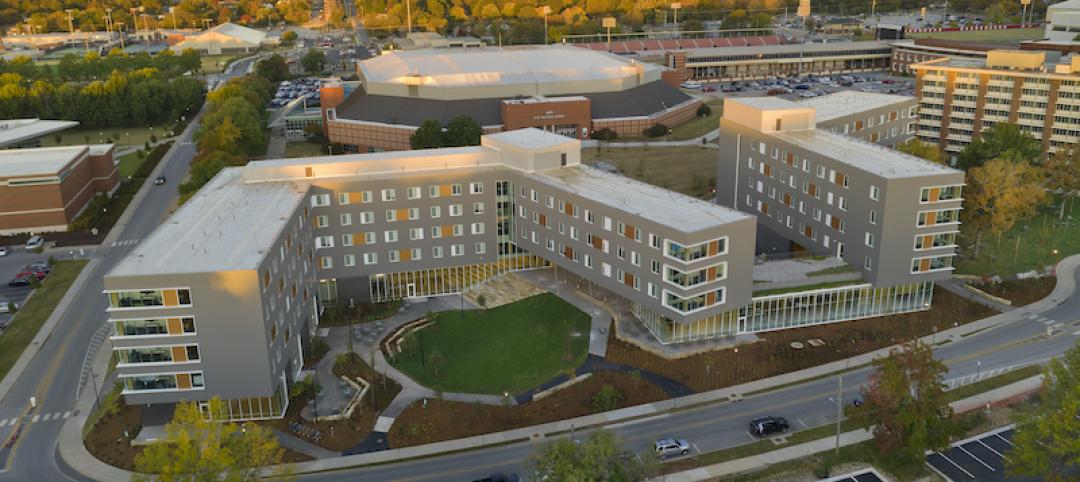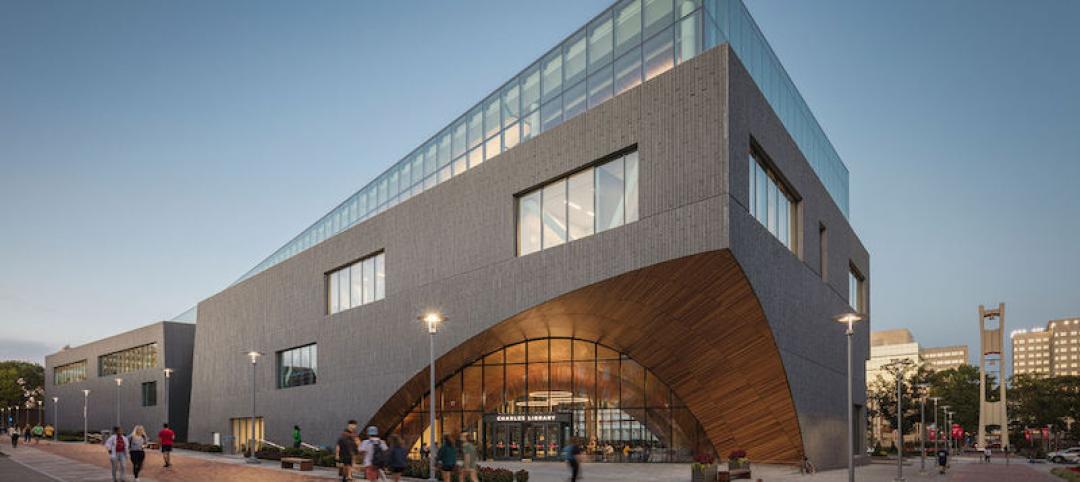In 2012, the 90,000-sf Molecular Engineering and Sciences Building was completed on the University of Washington Campus. This past summer, the five-story, 78,000-sf Nanoengineering and Sciences Building was completed. The two connected buildings make up a 168,000-sf complex that accommodates growth in the molecular engineering and nanoengineering fields, responds to the evolving interdisciplinary nature of teaching and research, and fits within a historic, high-density area of the UW campus.
The new $87.8 million, ZGF Architects-designed nanoengineering building will house the UW Institute for Nano-Engineered Systems and is specifically equipped for the performance or organic, inorganic, and biomolecular synthesis. The limestone, aluminum and glass curtain wall facility can accommodate students and faculty in a variety of nanoengineering disciplines such as energy, materials science, computation, and medicine.
 Photo: Aaron Leitz Photography.
Photo: Aaron Leitz Photography.
Flexibility of space was a driver for both phases of the complex. Research labs were designed to adapt as the equipment, research, and faculty change. Overhead service carriers above the lab benches allow for researchers to “plug and play” in any location. At the end of each lab there are rooms that can be arranged to house large equipment or specialty research spaces.
In addition to the labs, the new building also includes general-purpose classrooms, conference rooms, and collaboration spaces. Floors two through four are programmed research laboratory spaces. The first floor includes two highly adaptable classrooms and a shared, informal learning center.
Because the nanoengineering building has mainly southern and northern exposures, ZGF needed a strategy to address the added heat loads to the building due to the different orientation from phase one. Radiant flooring is used for heating and cooling purposes and chilled sails are used in the ceilings along the south wall of the office spaces. The units are ceiling-mounted and flush to the ceiling plane.
 Photo: Aaron Leitz Photography.
Photo: Aaron Leitz Photography.
The new facility incorporates numerous sustainability features such as rain gardens and green roofs planted with vegetation to attract native bees. Stormwater runoff will be directed to the roof gardens to reduce runoff to additional drainage systems.
One of the more unique sustainable features is the use of phase-change materials (PCM). PCM is a gel that becomes warm and liquid during the day and solidifies at night. It is encapsulated in walls and ceiling panels of the naturally ventilated spaces and reduces temperature as it changes material states. The PCM is composed of an inorganic material base and is “charged” at night when windows to office spaces are automatically opened to provide a flush of cool air. The PCM has been shown to reduce the temperature around 1.5 to 2 degrees during peek times on the hottest days of the year.
 Photo: Aaron Leitz Photography.
Photo: Aaron Leitz Photography.
The building team included Hoffman Construction Company (GC), KPFF (civil engineering, structural engineering), AEI (MEP), Site Workshop (landscape architecture), Research Facilities Design (lab planning), and Studio SC (graphics, wayfinding signage).
 Photo: Aaron Leitz Photography.
Photo: Aaron Leitz Photography.
 Photo: Aaron Leitz Photography.
Photo: Aaron Leitz Photography.
Related Stories
University Buildings | Jan 6, 2020
Making it: Gen Z learns by doing
This fundamental shift in learning style will have an impact on higher-education space planning.
University Buildings | Dec 17, 2019
Two LMN Architects-designed academic science buildings move forward for completion next year
These facilities will bring several disciplines under one roof.
University Buildings | Dec 12, 2019
HOK will design the Florida Gators new football facility
The facility will be named after longtime donor to the University of Florida and the University Athletic Association James W. “Bill” Heavener.
Wood | Dec 6, 2019
The University of Arkansas is now home to America’s largest mass timber building
A design collaborative led by Leers Weinzapfel Associates, Modus Studio, Mackey Mitchell Architects, and OLIN designed the project.
University Buildings | Nov 1, 2019
Design unveiled for the University of Maryland’s School of Public Policy building
LEO A DALY, in association with VJAA, designed the building.
University Buildings | Oct 28, 2019
Eight projects showcase the latest trends in student housing
Join us on a tour of select student residences at some of America’s top four-year colleges and universities.
University Buildings | Oct 10, 2019
Duke’s Hollows Quad residence halls provide housing for 700 upperclassmen
William Rawn Architects designed the project.
Libraries | Oct 2, 2019
Temple University’s Charles Library includes a ‘BookBot’ storage and retrieval system
The project was designed by Stantec and Snøhetta.
University Buildings | Sep 30, 2019
UMass Amherst’s Worcester Commons to be built on an existing parking lot
Shawmut, in partnership with Perry Dean Rogers and Connor Architecture, are designing the project.
University Buildings | Sep 23, 2019
Engineering Innovation Hub completes on SUNY New Paltz campus
Urbahn Architects designed the project.

















